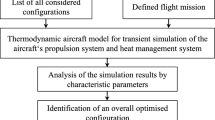Abstract
A method for calculating the optimal ratio of the fuel and solid propellant in the gas generator of a high-velocity flying vehicle is proposed. A thermodynamic approach is used to describe the processes in the gas generator. The ratio of the solid propellant and fuel in the gas generator is determined by their physical and chemical properties. An increase in the density and heat of combustion of the solid propellant and in the fuel porosity leads to reduction of the volume fraction of the solid propellant in the gas generator. An increase in the density, specific heat, specific heat of sublimation, and temperature of sublimation of the fuel leads to an increase in the volume fraction of the solid propellant in the gas generator.
Similar content being viewed by others
References
L. S. Yanovskii, A. V. Baikov, and I. S. Aver'kov, “Estimation of the Possibility of Creation of a Ramjet Operating on a Solid Propellant with an Active Cooling System,” Tepl. Prots. Tekh. 8 (3), 111–116 (2016).
E. L. Kondratyuk, “Investigations performed in the USA in the Field of the Development of Hypersonic Flying Vehicles,” Dvigatel 85 (1), 8–11 (2013).
V. A. Shandakov, A. S. Zharkov, V. N. Strelnikov, et al., Physical and Chemical Fundamentals of Creation of Elements for Low-Temperature Gas Generators for Various Purposes (Fizmatlit, Moscow, 2011) [in Russian].
S. V. Kalinin, A. I. Shaburin, V. I. Sarab'ev, et al., “Investigation of Thermodynamic Characteristics of Pyrotechnical Gas-Generating Compositions for Low-Temperature Gas Generators,” Vestn. Tekhnol. Univ. 20 (2), 44–46 (2017).
K. Yu. Aref'ev, K. V. Fedotova, L. S. Yanovskii, et al., “Investigation of the System for Cooling Cylindrical Channels by Products of Gasification of Solid Hydrocarbon Fuels,” Izv. Vyssh. Uchebn. Zaved., Mashinostr., No. 1, 86–98 (2017).
K. V. Fedotova, K. Yu. Aref'ev, A. V. Sukhov, and L. S. Yanovskii, “Investigation of Mixing of Products of Gasification of Solid Hydrocarbons with a High-Enthalpy Gas Flow in Constant-Section Channels,” Vestn. MGTU Baumana, Ser. Mashinostroenie, No. 4, 11–27 (2017).
R. I. Kurziner, Jet Engines for Large Supersonic Flight Velocities (Mashinostroenie, Moscow, 1989) [in Russian].
A. V. Baikov, A. V. Peshkova, A. V. Shikhovtsev, and L. S. Yanovskii, “Experimental Investigations of a Low-Temperature Solid-Propellant Gas Generator for Air-Breathing Engines,” Gorenie Vzryv 9 (4), 126–131 (2016).
E. A. Salganskii, V. M. Kislov, S. V. Glazov, et al., “Specific Features of Filtration Combustion of a Pyrolized Solid Fuel,” Fiz. Goreniya Vzryva 46 (5), 42–47 (2010) [Combust., Expl., Shock Waves 46 (5), 528-532 (2010)].
S. V. Glazov, E. A. Salganskii, V. M. Kislov, et al., “Change in the Structure of the Filtration Combustion Wave due to a Fuel Composition Change,” Fiz. Goreniya Vzryva 46 (3), 52–58 (2010) [Combust., Expl., Shock Waves 46 (3), 286-292 (2010)].
E. A. Salganskii, V. P. Fursov, S. V. Glazov, et al., “Model of Air Gasification of a Solid Fuel in a Filtration Regime,” Fiz. Goreniya Vzryva 39 (1), 44–50 (2003) [Combust., Expl., Shock Waves 39 (1), 37-42 (2003)].
B. G. Trusov, “Program System TERRA for Simulation Phase and Thermal Chemical Equilibrium,” in Proc. of the XIV Int. Symp. on Chemical Thermodynamics (St. Petersburg, 2002), pp. 483–484.
Polymer Handbook. Ed. by J. Brandrup, E. H. Immergut, E. A. Grulke, A. Abe, and D. R. Bloch (Wiley, 1998).
V. I. Trushlyakov, D. B. Lempert, and M. E. Bel'kova, “Possibility of Using Gas-Generating Compositions for Increasing the Rocket Propulsion Efficiency,” Fiz. Goreniya Vzryva 51 (3), 48–54 (2015) [Combust., Expl., Shock Waves 51 (3), 326-332 (2015)].
Author information
Authors and Affiliations
Corresponding author
Additional information
Original Russian Text © E.A. Salgansky, Kh.R. Makhmudov, A.V. Baikov, L.S. Yanovskii.
Rights and permissions
About this article
Cite this article
Salgansky, E.A., Makhmudov, K.R., Baikov, A.V. et al. Thermodynamic Estimate of the Optimal Ratio of the Solid Propellant and Fuel in the Gas Generator of a High-Velocity Flying Vehicle. Combust Explos Shock Waves 55, 702–707 (2019). https://doi.org/10.1134/S001050821906011X
Received:
Revised:
Accepted:
Published:
Issue Date:
DOI: https://doi.org/10.1134/S001050821906011X




